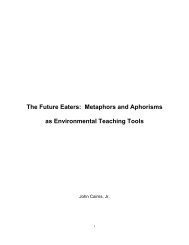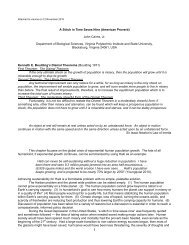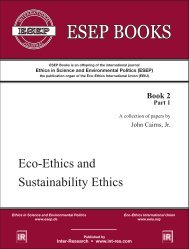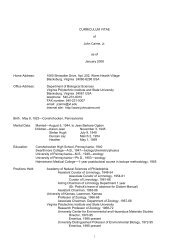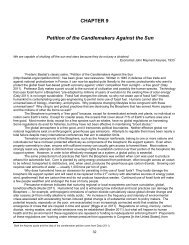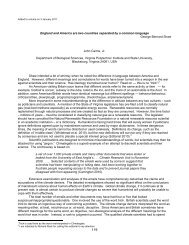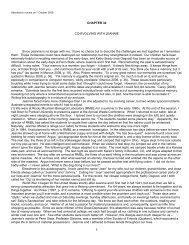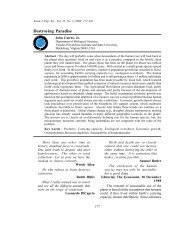View - ResearchGate
View - ResearchGate
View - ResearchGate
Create successful ePaper yourself
Turn your PDF publications into a flip-book with our unique Google optimized e-Paper software.
248Cairns: Eco-Ethics and Sustainability Ethicscannot reasonably expect the over 3 billion individuals living on US$3/capita/day or less to spendany significant amount of time on sustainability when their primary concern is survival. On the otherhand, for the more affluent, time remaining in a busy schedule is often used to achieve status.Economist Kenneth Boulding (1956) asserted that, beyond a certain degree of complexity, thehuman mind substitutes symbolic images for imagination. Environmental biologist Hardin advocatedasking ‘and then what’ questions to detect unexpected consequences of focusing toointently on a single goal (e.g. economic development or exponential growth). 1OBSTACLES TO TRANSDISCIPLINARITYRemarkable progress has been made in overcoming the obstacles to transdisciplinary activitiesin the over 55 years I have been engaged in these activities. Both individuals and disciplines haveexperienced intellectual and financial benefits from this progress. Wilson (1998) believes this trendis irreversible and provides persuasive evidence to support his view. The major issue now rests onwhether the rate of change will be adequate to enable humankind to have the information essentialto achieve sustainable use of the planet. Unsustainable practices are still the norm, and naturalcapital is being depleted at a rate far in excess of its regeneration.Most collaborations are still interdisciplinary and typically involve only two disciplines. Interdisciplinaryis the appropriate term since the boundaries of the disciplines are quite evident, but the goalrequires the participation of both. A major effort should be made toward synthesis of all phases ofthe relationship. This design is a distinct improvement over multidisciplinary studies in which eachdiscipline has a separate approach toward a common goal, with synthesis or a series of feedbackloops between or among the disciplines, so that information generated in [each] bears only tokeninfluence on the activities of the others. Transdisciplinary activities require that the research orproblem-solving design not be dominated by the disciplines, that robust synthesis be a major goal,that disciplinary jargon be absent or kept to a minimum, that communication between and amongthe disciplines be sufficiently effective so that mid-course corrections can be made in all componentsbecause of information generated by others, and that the results be comprehensible to reasonablyintelligent laypersons.JOURNALS AND THE COEVOLUTIONARY PROCESSA major contribution to this co-evolutionary process could come from journals that aspire to betruly transdisciplinary. These journals would provide an opportunity for transdisciplinary groups topublish their concepts and information without being hampered by the detailed knowledge baseand complicated terminology essential to specialized journals. At the same time, transdisciplinaryjournals must adhere to rigorous quality control measures comparable to specialized journals. Thisundertaking is indeed a formidable task.An important feature of producing these journals is the avoidance of endless repetition of informationessential to understanding transdisciplinary papers so that the primary message of themanuscript is unmistakable. For example, the field of ethics comprises many subdivisions of greatinterest to ethicists but that are not essential to a manuscript for which a dictionary definition ofethics is adequate. Meeting the disciplinary requirements of a specialized journal on ethics is notappropriate for a transdisciplinary journal and may hamper communication with non-specialists.1 See www.garretthardinsociety.org/info/quotes.html



